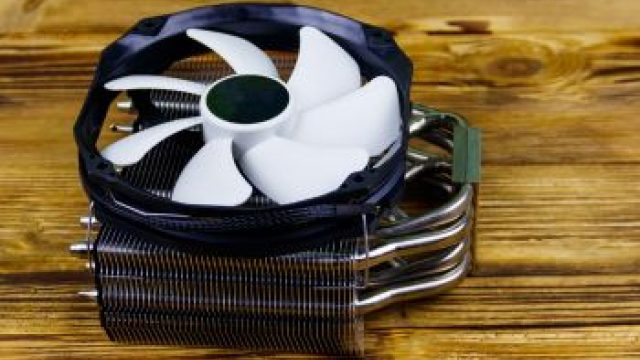In today’s technology-driven world, computers have become an indispensable part of our lives. Whether you’re a gamer, a content creator, or simply using your computer for daily tasks, one thing remains constant – the need to keep your CPU cool.
The CPU, or Central Processing Unit, is the brain of your computer, and it generates a substantial amount of heat while handling all the computations. That’s where the CPU cooler comes into play, ensuring that your processor remains within safe temperature limits.
In this article, we will delve into the significance of a CPU cooler, learn how it works, and explore how to check if it’s functioning correctly.
What is a CPU Cooler and How Does It Work?
A CPU cooler is a vital component of your computer that regulates the temperature of the CPU. It consists of a heatsink, which is a metal component that dissipates heat, and one or more fans that aid in the cooling process.
When your computer is running, the CPU continuously performs calculations, and this generates heat. Without adequate cooling, the CPU could overheat, leading to reduced performance, system crashes, and potentially even permanent damage.
The CPU cooler works by absorbing the heat generated by the CPU and dispersing it into the surrounding air. The heatsink, usually made of aluminum or copper, has a large surface area that facilitates the transfer of heat away from the CPU.
The fans mounted on the heatsink help in pushing air over the surface, enhancing the cooling process. Some CPU coolers also employ a heat pipe technology, which further improves heat transfer efficiency.
Preparing for the Check
Before diving into the process of checking your CPU cooler, it’s essential to take some preparatory steps. Firstly, ensure that your computer i turned off and disconnected from the power source.
This precautionary measure ensures your safety during the inspection process and prevents any potential electrical mishaps. Additionally, you might need a few basic tools, such as a screwdriver and a can of compressed air, to carry out the examination effectively.
Related Article: How To Build A Small Form Factor Pc
How To Check CPU Cooler is Working
Now comes the critical part – checking if your CPU cooler is functioning correctly.
By following this step-by-step guide, you can assess your CPU cooler’s performance and address any issues that may arise.
Step 1: Shutting Down the Computer and Disconnecting Power
Before you do anything else, shut down your computer properly. Once it’s off, unplug the power cord from the electrical outlet to ensure there’s no electricity flowing through the system.
Step 2: Opening the PC Case
To access the CPU cooler, you’ll need to open your PC case. Depending on your computer’s design, you might need to remove one or more side panels. Keep the screws safely aside as you’ll need them to reassemble the case later.
Step 3: Locating the CPU Cooler and Fan(s)
Once the case is open, locate the CPU cooler and its fan(s). The CPU cooler is positioned directly on top of the CPU, and you’ll usually find a fan or fans mounted on the heatsink.
Step 4: Inspecting for Physical Damage or Obstructions
Carefully examine the CPU cooler and fan(s) for any signs of physical damage or obstructions. Look for bent fins on the heatsink or any debris that might be blocking the fan blades.
Physical damage or obstructions can hinder proper cooling and lead to overheating.
Step 5: Cleaning Dust and Debris from the Cooler and Fan(s)
Dust and debris accumulation over time can impede the cooling efficiency of your CPU cooler. Use a can of compressed air to blow away the dust from the heatsink and fan(s).
Ensure that the system is off during this cleaning process.
Step 6: Verifying Fan Movement and Connections
Gently spin the fan blades with your fingers to check for smooth movement. If a fan doesn’t spin or feels stiff, it might be malfunctioning and require replacement.
Also, inspect the fan connections to the motherboard to ensure they are secure.
Step 7: Assessing the Thermal Paste (if applicable)
In some cases, the CPU cooler uses thermal paste to improve heat transfer between the CPU and the heatsink.
If you’ve had your CPU cooler for a while, the thermal paste might degrade, affecting cooling performance. Consider reapplying thermal paste if necessary, following manufacturer guidelines.
Related Article: How To Build A Small Form Factor Gaming Pc
Monitoring CPU Temperature
After inspecting and potentially cleaning or repairing your CPU cooler, it’s essential to keep an eye on your CPU temperature regularly.
You can use various software tools to monitor your CPU temperature and ensure it stays within safe limits during heavy usage.
Benchmarking CPU Cooler Performance
For the tech-savvy enthusiasts seeking optimal CPU cooling, benchmarking your CPU cooler’s performance can provide valuable insights.
Running stress tests and monitoring temperature changes can help you fine-tune your cooling setup for maximum efficiency.
Troubleshooting and Potential Solutions
If, despite your efforts, your CPU temperatures remain high, it could indicate more significant issues. In such cases, consider consulting with a professional or your computer manufacturer for further troubleshooting and potential solutions.
Best Practices for CPU Cooling
To ensure your CPU cooler continues to work efficiently and prolong the lifespan of your processor, adhere to these best practices:
- Clean your CPU cooler and fan(s) regularly to prevent dust buildup.
- Ensure proper airflow in your PC case by organizing cables and maintaining clear pathways for air circulation.
- Consider upgrading your CPU cooler if you’re an avid gamer or regularly perform demanding tasks on your computer.
- Use high-quality thermal paste and follow the manufacturer’s guidelines for application.
- Avoid overclocking your CPU excessively, as it can lead to higher temperatures and increased stress on your CPU cooler.
FAQs About How To Check CPU Cooler is Working
How do I know if my CPU cooler is working?
To check if your CPU cooler is functioning correctly, you can listen for any unusual noises, like rattling or grinding, which might indicate a fan issue.
Also, monitor your CPU temperature using software utilities or the BIOS to ensure it stays within safe operating limits.
How do I know if my CPU cooler is cooling enough?
By monitoring your CPU temperatures during idle and under load, you can assess if your CPU cooler is cooling efficiently.
Optimal temperatures should be within the manufacturer’s specified range and not exceed critical thresholds, leading to performance issues or shutdowns.
How long can a CPU cooler last?
The lifespan of a CPU cooler varies depending on its quality and usage. Generally, air coolers can last for several years, even a decade, with proper maintenance.
Liquid coolers might have a shorter lifespan due to the potential for pump failures or coolant leakage.
How do I check my CPU cooler temperature?
To check your CPU cooler temperature, you can use software utilities like HWMonitor, Core Temp, or MSI Afterburner.
Additionally, you can access the BIOS to view temperature readings. Ensure your CPU is under load to get accurate readings.
Does a cooler CPU run faster?
Yes, a cooler CPU can run faster and more efficiently. High temperatures can cause thermal throttling, reducing CPU performance to prevent damage.
A cooler CPU avoids such throttling, allowing it to maintain higher clock speeds and better overall performance.
Can a CPU cooler fail?
Yes, CPU coolers can fail over time. Fans can stop working, heat sinks can become clogged with dust, or liquid coolers may experience pump failures or coolant leaks.
Monitoring your CPU temperatures regularly can help identify potential cooler issues.
How do I troubleshoot my CPU cooler?
To troubleshoot a CPU cooler, first, ensure it’s correctly installed and securely attached to the CPU. Check the fan for any obstructions or damage.
Clean any accumulated dust on the heatsink or radiator. If using a liquid cooler, ensure there are no leaks and that the pump is functioning.
What happens when a CPU cooler dies?
When a CPU cooler fails, the CPU temperature can rapidly increase during operation.
As a result, the CPU might automatically shut down or trigger thermal protection mechanisms to prevent damage. Continuous operation with a failed cooler could lead to permanent CPU damage.
Do I have to refill liquid cooling for a PC?
In most cases, closed-loop liquid cooling systems do not require refilling. These sealed systems are designed to be maintenance-free.
However, custom liquid cooling setups may need occasional refills and maintenance, but closed-loop coolers usually do not.
What is the max temperature for a CPU cooler?
The maximum temperature for a CPU cooler varies depending on the CPU model.
Generally, most CPUs have a maximum safe operating temperature of around 70 to 90 degrees Celsius (158 to 194 degrees Fahrenheit). Exceeding these temperatures can lead to performance issues or damage.
What is the normal CPU temperature?
The normal CPU temperature varies based on factors like CPU model, workload, and ambient temperature.
For most modern CPUs, the idle temperature should be around 30 to 50 degrees Celsius (86 to 122 degrees Fahrenheit), while under load, it can reach 60 to 85 degrees Celsius (140 to 185 degrees Fahrenheit).
How do I know if my CPU is overheating?
If your CPU is overheating, you may experience system crashes, unexpected shutdowns, or sudden drops in performance.
Monitoring software can help you check the CPU temperature regularly, and if it consistently reaches high temperatures (above 90 degrees Celsius), it might indicate overheating.
Final Thoughts About How To Check CPU Cooler is Working
Ensuring your CPU cooler is working optimally is crucial for system stability and performance. Regularly monitoring CPU temperatures using software utilities or accessing the BIOS helps verify proper functionality.
Listen for any unusual noises that could indicate fan issues. If the CPU cooler is cooling efficiently, the CPU temperature should stay within the manufacturer’s specified range, avoiding thermal throttling and performance degradation.
In case of suspicion, cleaning the cooler and ensuring a secure installation can resolve minor issues. Remember, a well-functioning CPU cooler contributes to a cooler and faster CPU, safeguarding your system from potential damage caused by overheating.


